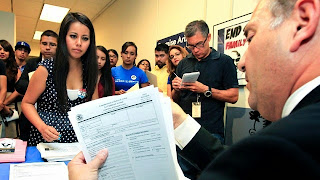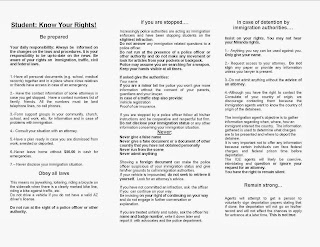1.-DACA (Deferred
Action for Childhood Arrivals). It
wasn’t because one day President Obama decided to be nice with the embattled
DREAMers. It was a calculated political
move plus the result of DREAMers across the nation pressuring POTUS. The ADAC
participated in the Right to DREAM Campaign, protesting in front of ICE’s
offices and engaging the White House through social media. Efforts came on
different fronts, using different tactics. 96 Law professors across the nation signed a letter to President Obama stating “Yes, You Can” give reprieve from
deportation to DREAMers in response to President Obama's reluctance to use his
executive powers to alleviate the DREAMers' situation . More
on the letter to President Obama here. Arizona State University Professor Evelyn
Cruz was one of the signatories to the letter. This “DREAM Act light” was the
most significant victory in the immigrant rights movement in a generation.
2.-In State Tuition
at Maricopa County Community Colleges. One of our biggest victories. Legal Department
and authorities at Maricopa County Community Colleges District (MCCCD), one of the largest
colleges systems in the nation, were quick to find legal justification to offer
In-Sate-Tuition to DACA grantees. This
move was in spite of Jan Brewer’s executive order denying Arizona IDs and Driver’s
licenses to DACA grantees. MCCCD kept the list of documents for
in-state-tuition that was in place since the times of Prop. 300 implementation. Governor Brewer, in an authoritarian move,
changed the list of documents for granting Arizona State IDs and Driver’s
Licenses eliminating the working authorization (I-766).
The quick and resolved response from MCCCD authorities came
thanks to the intense protesting and scrutiny the previous implementation of
out of state tuition policies got since April 2011.
Long story short, we DREAM advocates put pressure on MCCCD in public and
many, MANY, private meetings to show our displeasure on the disappearance of
all reasonable tuition fees for immigrant youth. Here
is an article on the series of protests by journalist Gregory Pratt.
The tuition hike came with subsequent collapse of the enrollment of undocumented students and the near collapse of some programs.
The tuition hike came with subsequent collapse of the enrollment of undocumented students and the near collapse of some programs.
MCCCD was able to turn around
the situation, find common sense, courage and offer a hopeful alternative for higher education that will
benefit Arizona's future work force.
4.- No DREAM Deferred-NDD.
With more than 1000 DACA applications submitted through the workshops and
countless orientation for DACA applicants, NDD Coalition deserves a spot on the
greatest Arizona DREAM moments of 2012. NDD is an all volunteer and free
service to young people coordinated by DREAMers from ADAC with the invaluable
professional help of AILA Lawyers plus other partnering community organizations. Great collaboration and team work in spite of
the monetary limitations.
5.- Dulce Matuz, One
of the 100 More Influential Persons in the World by TIME Magazine.
It was a great recognition of Dulce Matuz’s leadership (an ASU electrical engineer graduate and Carl Hayden Falcon Robotics alumna) but also national recognition of the DREAM Act movement en Arizona. She is the first to point out the volunteer work and many sacrifices of all the active members of the movement who contribute to her effective leadership.
It was a great recognition of Dulce Matuz’s leadership (an ASU electrical engineer graduate and Carl Hayden Falcon Robotics alumna) but also national recognition of the DREAM Act movement en Arizona. She is the first to point out the volunteer work and many sacrifices of all the active members of the movement who contribute to her effective leadership.
Bonus top moments!
GED enrollment for
DACA applicants. Deferred Action for Childhood Arrivals came, for DREAMers
who had not completed High School, with an opportunity to engage in education
though enrollment on GED programs. In
spite of the many challenges this subgroup confronts it represents hope to
young people to attain legal presence, work permit and a platform where they
may construct personal educational improvement.
It would benefit individuals, families and the overall community.
Civil Rights Center-Department
of Education Federal Complaint Against MCCCD. The tuition hike mentioned on
top moment number 2 brought scrutiny from community members and specially
Silverio Garcia of the Civil Rights Center. MCCCD was treating
Undocumented Charter High School students like community college students and submitting
them to harsh immigration-education policies. K-12 students are protected
from legal status inquiries. CRC opened the door for the Department of
Education to intervene. Ruling is still
pending but it was a great experience in advocacy, tools we can use in the
future and returning some power to the community. Here
is an Arizona Republic article on the issue.
Undocumented Youth on
Time Magazine.
American Citizens in waiting article featured amazing Arizona advocates Erika Andiola and Christian Lira among the national stars line up. Another signal the DREAM Act movement have reached the notoriety from a little known legislation back in the day I started to advocate. Click for the TIME magazine cover and article here.
Don't Let Them Behind. 465 dollars can be a lot of money for immigrant youth, limiting for some the opportunity to apply for DACA. Fortunately an anonymous donor contacted Chicanos por la Causa to start a fund providing the USCIS- DACA application fees for DREAMers in need. CPLC is reaching out to the community to grow the fund. I have been privileged to participate in the creation of the effort and witnessed DREAMers getting their checks to USCIS for their application. However, there is a lot of need for more funds like this to be created around the country. Start one ! Click here to donate !
Happy New Year 2013!
American Citizens in waiting article featured amazing Arizona advocates Erika Andiola and Christian Lira among the national stars line up. Another signal the DREAM Act movement have reached the notoriety from a little known legislation back in the day I started to advocate. Click for the TIME magazine cover and article here.
Don't Let Them Behind. 465 dollars can be a lot of money for immigrant youth, limiting for some the opportunity to apply for DACA. Fortunately an anonymous donor contacted Chicanos por la Causa to start a fund providing the USCIS- DACA application fees for DREAMers in need. CPLC is reaching out to the community to grow the fund. I have been privileged to participate in the creation of the effort and witnessed DREAMers getting their checks to USCIS for their application. However, there is a lot of need for more funds like this to be created around the country. Start one ! Click here to donate !
Happy New Year 2013!










